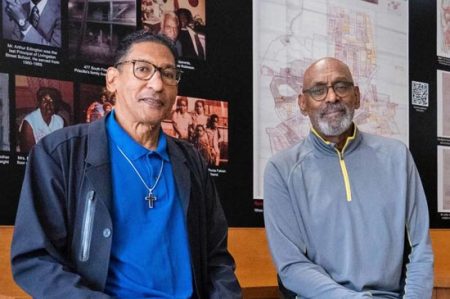Eagle Market Renaissance

After a long, slow decline, “The Block” might at last be poised for a comeback.
For more than a decade the sad, once-beautiful façade of the Del Cardo
building has stood as the gateway to the historical Eagle-Market Street
“Block” community. Around the corner, the Collette building is a
boarded-up blight on Eagle Street. Farther east, three moribund
industrial structures inhabit the neglected area between the YMI and
the Mt. Zion Missionary Baptist Church.
In recent years the renovated Ritz building, like the vibrant YMI across Market Street, has brought people and energy to The Block, and the Reuben Dailey building next door has housed a number of small businesses. But these bright spots scarcely compensate for the overall feeling of neglect. Looming over the neighborhood are the unprepossessing backside of the Pack Place parking garage and the walled-in rear end of the Municipal Building. From inside the YMI the street view encompasses the Del Cardo’s boarded-up windows and the Ritz’s parking lot; from inside the Ritz, it’s an empty factory and two overgrown lots.

Long History of Neglect
The slow, inexorable decline of The Block has been part of downtown Asheville’s narrative for more than 40 years, ever since 1960s’ urban renewal tore the heart out of this downtown East-End community. Splashy plans for the neighborhood’s rebirth, and their subsequent collapse, have also been regular features in the news pages. Financing has been obtained, only to be withheld when other property owners sued; city approval for various development plans has been tentatively given and then withdrawn. Two nonprofits — Eagle-Market St. Development Corp. and Mt. Zion Community Development, Inc. — have offered numerous plans to redevelop the area, but over the years their rivalry has developed little more than bad feelings in the community.
Skin in the Game
Now, however, there’s a multi-use project planned for the long-neglected corner at the heart of The Block that is bringing together development boosters who in the past have often been antagonists rather than colleagues. Those joining in common cause to support the plans include Darryl Hart, Jr., Chairman of Eagle-Market Streets Development Corp.; Dr. John H. Grant, pastor of Mt. Zion Baptist Church; Attorney Eugene Ellison, owner of The Ritz building; and representatives of the YMI and the South Market/Eagle Business Tenant Association.
 |
| Principal partners in Eagle Market Renaissance, LLC – Tayani Suma (left), President, Mission Redevelopment Inc., Michael Johnson (center), President, E.M. Johnson Interest Inc., and Sylvia Farrington, President and CEO, Asheville Global Services Inc. Photo: Joe Carney/Urban News |
At the center of the Eagle-Market Streets Renaissance (EMR-LLC) and Eagle-Market Streets Development Corporation’s partnership is Atlanta- and San Francisco-based Michael Johnson, President of E. M. Johnson Interest, Inc. The other partners are Sylvia Farrington, president of Asheville Global Services, Inc., and Tayani Suma, president of Mission Redevelopment Inc. of Atlanta, Georgia.
Ellison points out that the developer, like the local participants, “will have skin in the game.” That fact alone makes it more likely that these plans will move forward. While a nonprofit entity like Pack Square Conservancy can stumble forward at what seems a few inches at a time, a for-profit developer must get the returns from an investment rolling in as soon as possible.
Johnson’s experience includes urban redevelopment and providing a full range of consulting services to neighborhood organizations, government agencies, and private businesses. Its most notable project is the Filmore Heritage Center in San Francisco.
Suma, of Atlanta, says, “Michael’s firm will act as our lead partner. The company emphasizes partnerships between the public, private and community sectors, and is known to successfully bring these groups together to implement projects. E.M. Johnson Interest was founded as a minority business enterprise in 1979 and has been a leading real estate development company for more than fifteen years.
“[Mission Redevelopment] will act as project directors, and work with local consultants” to move the project forward, she says. “We bring to the table years of experience” in real estate and economic development in disinvested communities.” Suma has worked on projects using historic and low-income housing tax credits, taxable and tax-exempt bond financing, conventional debt and equity, and assorted grant and subsidy programs.
The local partner is Sylvia Farrington, president and CEO of Asheville Global Services Group, Inc., which specializes in the development of public-private and academic community-based initiatives.
 |
| Looking north toward Eagle Street |
Suma also emphasizes that “the project is in the preliminary, pre-development phase” and notes that the team is still working on various due-diligence activities prior to identifying project funding sources.
Preliminary architectural renderings show 77 rental apartments, a parking garage, and three or four separate retail areas that could include a number of individual businesses. The apartments shown include two efficiency, 34 one-bedroom, and 41 two-bedroom units. Some will be designated “affordable housing,” and some have attractive terraces overlooking Market Street on the east or Wilson Alley on the west.
Under its separate plan, the Mount Zion Community Development Corp. plans to tear down the three defunct industrial buildings it owns and replace them with new affordable housing.
So, will the disputes that have repeatedly confounded plans for the rebirth of The Block arise again, or have the principal players at last reached a consensus that will lead to success? Ellison also notes that the participants were “all included from the very beginning,” a very different situation than in the past.









